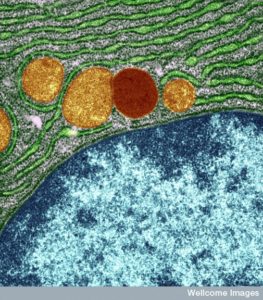 All of life is based on interactions of signaling entities—communities, people, organs, cells, and even viruses. Remarkable progress has been made in deciphering the conversations between cells, but it is much harder to track signals among organelles. Observation is much more difficult because they are so much smaller. It does appear that the same types of ongoing communication occur as in cells.
All of life is based on interactions of signaling entities—communities, people, organs, cells, and even viruses. Remarkable progress has been made in deciphering the conversations between cells, but it is much harder to track signals among organelles. Observation is much more difficult because they are so much smaller. It does appear that the same types of ongoing communication occur as in cells.
Recently, signals have been found for organelle communication about building and maintaining proteins, and in the adaptations to stress in yeast. It is still too difficult to find this level of signaling among organelles in humans. Even complete genetic mapping of an organism related to protein function doesn’t necessarily answer these questions. While communication among organelles is obviously occurring, this research uncovered some of the first definite detailed conversations among organelles.
 The current research shows how all of the organelles engage in certain jobs that are inherent to their functions and these involve pathways of signals and transport between all the cell’s compartments. But, when one falters, then the others are shown to pick up the slack with changes through signals. Also, it is shown that the cell at large has its own processes that can kick in. Some of these ways that organelles cooperate and signal can avoid the death of a cell in stress, and some do the opposite promote a downhill spiral of actions.
The current research shows how all of the organelles engage in certain jobs that are inherent to their functions and these involve pathways of signals and transport between all the cell’s compartments. But, when one falters, then the others are shown to pick up the slack with changes through signals. Also, it is shown that the cell at large has its own processes that can kick in. Some of these ways that organelles cooperate and signal can avoid the death of a cell in stress, and some do the opposite promote a downhill spiral of actions.
One way to find this information has been to analyze the quality controls that take care of proteins in all of its aspects—manufacture, maintenance, recycling, degradation, and taking care of misfolded clumps.
Many Organelles and Many Different Pathways
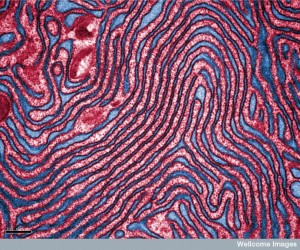 Interactions are being observed for mitochondria, nuclei, lysosomes, Golgi, and endoplasmic reticulum. Interactions are also seen with other vesicles such as peroxisomes, and in the many kinds of membranes inside and around the cell. One of the big transfers involve proteins that need to be called for, built, transported, and then degraded and disposed of.
Interactions are being observed for mitochondria, nuclei, lysosomes, Golgi, and endoplasmic reticulum. Interactions are also seen with other vesicles such as peroxisomes, and in the many kinds of membranes inside and around the cell. One of the big transfers involve proteins that need to be called for, built, transported, and then degraded and disposed of.
Analysis is made of systems that have a very large amount of moving parts—most cellular functions. This analysis can predict “emergent” properties such as transfer of information, changing over time, multiple local interactions, longer interactions with modification, interaction with environmental signals, interaction loops, needing energy for the system to operate (not equilibrium), past influences creating the present.
Complex systems are altered, perhaps by a metabolic shift, and then the network can rewire and send new messages. These new circuits of messages can occur quickly or over long term evolution. The system that has been most analyzed is related to making sure proteins functions and relieving problems based on abnormal protein clumps, that can cause many diseases.
Quality Control of Proteins
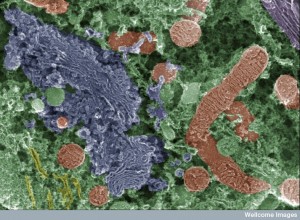 Communication among a variety of organelles is needed for protein construction and maintenance. Stress or aging can alter one or more of these subunits of the communication. This can stimulate alterations in the other compartments allowing continuance of functions for a while even with an impaired organelle, such as defective mitochondria.
Communication among a variety of organelles is needed for protein construction and maintenance. Stress or aging can alter one or more of these subunits of the communication. This can stimulate alterations in the other compartments allowing continuance of functions for a while even with an impaired organelle, such as defective mitochondria.
The quality of proteins involves a large number of different conversations between organelles. In fact, multiple proteins and factors are needed for all aspects of production, regulation, and transport of proteins. Chaperone proteins are needed to first fold proteins before they can function and this process needs multiple additional factors. Specific enzymes are needed to cut pieces to stimulate function in each organelle. There are special nucleotide exchange factors from the nucleus, the proteasome (that takes apart unneeded or damaged proteins), and a system of tagging with ubiquitin for transport. Particular sets of factors deal with clumps of misfolded proteins and the normal response to dysfunctional proteins—called the abnormal folding response.
 Along with the global quality programs of the cell, each organelle has their own quality systems interacting with each. Some molecules are shared in each of these processes. An example of this sharing occurs with both the endoplasmic reticulum (ER) and the cell using the Hsp70 molecules. This heat shock protein is used in the ER and mitochondrion to deal with misfolded or damaged proteins.
Along with the global quality programs of the cell, each organelle has their own quality systems interacting with each. Some molecules are shared in each of these processes. An example of this sharing occurs with both the endoplasmic reticulum (ER) and the cell using the Hsp70 molecules. This heat shock protein is used in the ER and mitochondrion to deal with misfolded or damaged proteins.
Problems in either of these organelles can affect the other. A special chaperone molecule (Sis1) for this vital regulatory molecule Hsp70 can be altered and this then causes problems in communication to the nucleus. The problem is that when this is altered, then the system whereby Sis1 sends proteins to be degraded malfunctions.
Another shared protein is Cbs2, which is important in mitochondria and nucleus. In the mitochondria it is one of several factors that activate part of the cytochrome oxidase process (the complex way that mitochondria make energy). When another factor is low, Cbs2 and the cytochrome oxidase process is not working in the mitochondria, more of it stays in the nucleus. This is a signal to resist stress in other ways than via the mitochondria and maintain the cell’s function and survival.
These are examples of issues in ER that affects mitochondria and nucleus, and another where problem in mitochondria affects the nucleus.
Trafficking Protein Clumps to Protect the Cell
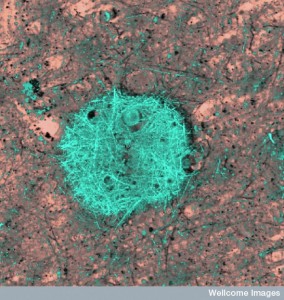 When clumps of mis folded proteins occur there is activity aimed at moving these to particular cell compartments to deal with the protential damage that could occur. With stress to the cell’s activity, one version being heat shock, small clumps of proteins have been called a variety of names in various research—Q-bodies, CytoQs, peripheral aggregates.
When clumps of mis folded proteins occur there is activity aimed at moving these to particular cell compartments to deal with the protential damage that could occur. With stress to the cell’s activity, one version being heat shock, small clumps of proteins have been called a variety of names in various research—Q-bodies, CytoQs, peripheral aggregates.
These special compartments to deal with protein clumps can be in the ER, mitochondria, vacuole, or elsewhere in the cell. They can be merged together into multiple different larger compartments that hold clumps. These are called inclusions and have multiple other names (insoluble protein deposit (IPOD), juxta nuclear quality control (JUNQ) and intra nuclear quality control (INQ)
The process whereby clumps are sent to these compartments need a variety of molecules including helper proteins such as chaperones, special enzymes, and other factors. Another process needs other specific factors to corral these proteins into a particular space often prior to being transported to the larger inclusion bodies. There are other signals that are needed among several organelles to tag specific proteins to be placed in these inclusion bodies.
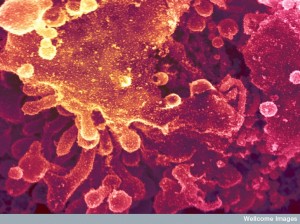 To gather, tag, and transport protein clumps, multiple pathways of communication and transport have been identified. These are part of many different pathways that have evolved for a long time in evolution and exist in most species. These pathways are vital for lipids, proteins, and metabolic products sent through pathways. A previous post described the vast complexity of just one of these pathways—the secretory pathway directed by the ER and Golgi to create, tag and transport lipids that are used in membrane throughout the body. The secretory pathway is vital for proteins because many involve attachment to lipids (lipoproteins) and to sugars (glycoproteins) that provide vast variability by taking one protein and attaching branching fats and sugars that have an almost infinite variations and uses.
To gather, tag, and transport protein clumps, multiple pathways of communication and transport have been identified. These are part of many different pathways that have evolved for a long time in evolution and exist in most species. These pathways are vital for lipids, proteins, and metabolic products sent through pathways. A previous post described the vast complexity of just one of these pathways—the secretory pathway directed by the ER and Golgi to create, tag and transport lipids that are used in membrane throughout the body. The secretory pathway is vital for proteins because many involve attachment to lipids (lipoproteins) and to sugars (glycoproteins) that provide vast variability by taking one protein and attaching branching fats and sugars that have an almost infinite variations and uses.
Protein pathways include:
- When proteins are first manufactured to be placed in the membrane of the cell it is via a pathway called SEC or secretory pathway (also for transport outside of the cell via exocytosis).
 The pathway for vacuolar protein sorting or VPS goes in the other direction to the vacuole for recycling and can use endocytosis processes.
The pathway for vacuolar protein sorting or VPS goes in the other direction to the vacuole for recycling and can use endocytosis processes.- A pathway helps this latter direction called the alkaline phosphatase or ALP.
- A pathway to send proteins from membranes is called the END pathway (for endocytosis) which transports proteins to be degraded or recycled in the Golgi through the RCY or recycling pathway.
All of these need multiple signals and factors including ways to connect sub units and vesicles such as SNARE proteins that are used for release of vesicles in synapses (see post) These need tagging also to get them to a particular site. Lipid signals appear vital in getting proteins from the membrane (phosphoinositides).
Many possible problems can interefere with these pathways. For example, problems can occur when material is sent from the Golgi to the vacuole regarding factors that pull together the inclusions as well as the tagging for transport directions. These defects can make what is a cluster to be dealt with to a toxic group that can cause damage.
 Misfolded proteins can interact with proteins and lipids in membranes by attaching to vesicles that travel near them. These involve pathways of vesicles from the Golgi and vacuole. A previous post has noted the details of the secretory pathway whereby the Gogli, the ER, work together to transport with tags all of the materials needs for membranes and vesicles throughout the cell. Some of the misfolded material can be sent in this transit to the vacuole. Prions in fact are part of one of these transport systems between organelles.
Misfolded proteins can interact with proteins and lipids in membranes by attaching to vesicles that travel near them. These involve pathways of vesicles from the Golgi and vacuole. A previous post has noted the details of the secretory pathway whereby the Gogli, the ER, work together to transport with tags all of the materials needs for membranes and vesicles throughout the cell. Some of the misfolded material can be sent in this transit to the vacuole. Prions in fact are part of one of these transport systems between organelles.
These processes allow the inclusion bodies to respond to help the cell in crisis. Only those cells that can take these clusters and move them can avoid damage. Aging can be slowed by boosting the process of transport into the IPODs. This larger process helps each of the organelles and the cell as well.
Communication of Organelles by Direct Contact of Special Sites
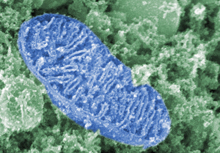 A previous post showed how vital the contact is between ER and mitochondria for all aspects of their communication. For this process of protein regulation, there are special sites on the membranes called membrane contact sites (MCS) when mitochondria and ER touch (ER-mito encounter sites or ERMES), and when vacuole and mitochondria touch (vacuole-mito patches or vCLAMPS), and when ER and vacuoles touch near the nucleus (ER-vacuolor junctions or NVJs).
A previous post showed how vital the contact is between ER and mitochondria for all aspects of their communication. For this process of protein regulation, there are special sites on the membranes called membrane contact sites (MCS) when mitochondria and ER touch (ER-mito encounter sites or ERMES), and when vacuole and mitochondria touch (vacuole-mito patches or vCLAMPS), and when ER and vacuoles touch near the nucleus (ER-vacuolor junctions or NVJs).
In fact, these special sites on membranes occur between all organelles—ER and plasma membrane; ER and endosomes or multi vesicular body; ER, nucleus and vacuole; ER and Golgi; ER and peroxisomes; ER and lipid droplets; mito and peroxisomes.
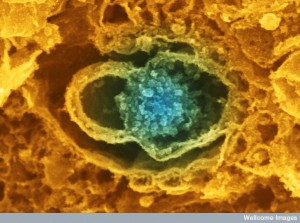 All of these have specific signals including fats, calcium, and other ions. These signals are necessary to control the relationships between the moving parts of the cell.
All of these have specific signals including fats, calcium, and other ions. These signals are necessary to control the relationships between the moving parts of the cell.
MCSs are now known to be important in immune function and apoptosis. These sites are specific micro environment that have particular fatty content for each function and conversation. Each type of interaction has special factors on both sites that connect. Lipid rafts are one version of special sites on membranes and these are also related to some of these communications. Previous posts have described in detail one version of this where axons and dendrites touch at the synapse, each has a very specialized site in the membrane (active site and post synaptic density)
A Change in One Organelle Affects the Other
 Signals also occur through small molecules including ions. When one organelle changes its small molecule content, this affects other organelles. pH in particular can affect the function of an organelle, such as the vacuole or lysosome. pH is the measurement of the amount of protons available in an organelle and this state has powerful communication affects (it stands for potential of hydrogen). The pH difference affects protein functions in particular because the action of enzymes and the chemical reactions among proteins are altered by different pH. It can affect the production of a protein and its interactions.
Signals also occur through small molecules including ions. When one organelle changes its small molecule content, this affects other organelles. pH in particular can affect the function of an organelle, such as the vacuole or lysosome. pH is the measurement of the amount of protons available in an organelle and this state has powerful communication affects (it stands for potential of hydrogen). The pH difference affects protein functions in particular because the action of enzymes and the chemical reactions among proteins are altered by different pH. It can affect the production of a protein and its interactions.
Lysosomes are also called vacuoles and they break down molecules for recycling and destruction. They are very acidic, which is used to destabilize and recycle molecules. This is highly connected with mTOR regulation as well, which senses the amount of amino acids, nucleotides, and fats in the cell and works with the vacuole to recycle material to be used. When pH control is altered, it not only changes the lysosome degradation but also affects protein maintenance and leads to misfolded proteins and clumps of abnormal proteins. It affects the entire quality control apparatus among all of the organelles. In mitochondria, this change produces more reactive oxygen molecules (ROS) that can produce problems along with protein damage. Transport is stopped with accumulation of abnormal proteins. It affects transport of vesicles causing more fusion.
The cell can respond to this problem globally to get around mitochondrial problems. It increases more action into the IPOD inclusion site. It also increases the endocytosis pathway to take negative material out.
These cellular responses are one example between all organelles to keep the cell alive during severe stress.
Processes of Organelle and Damage
 Another example of organelles and the cell as a whole working together occurs during replication of the cell. During cell division some damaged organelles and clumped proteins are sent into the new cell. This is managed in many different ways. These require active transport with actin scaffolding as part of the complex process that moves organelles, chromatin, and separates the cell. Damaged mitochondria are part of this transport and this is similar to that of protein clump transport. Cables are set up between the mother and daughter cell such as that actin goes backwards into the mother cell for this connection. Then myosin motors are used in the opposite direction.
Another example of organelles and the cell as a whole working together occurs during replication of the cell. During cell division some damaged organelles and clumped proteins are sent into the new cell. This is managed in many different ways. These require active transport with actin scaffolding as part of the complex process that moves organelles, chromatin, and separates the cell. Damaged mitochondria are part of this transport and this is similar to that of protein clump transport. Cables are set up between the mother and daughter cell such as that actin goes backwards into the mother cell for this connection. Then myosin motors are used in the opposite direction.
Normal mitochondria move faster than the damaged ones against this flow. This provides more positive good mitochondria for the daughter. It appears that the mechanisms that bring organelles into the child cell are connected to factors that both bring the protein clumps and the organelle. These seem to be connected to the contact site in the membrane of the organelle mentioned above. These motors are involved in most of the important organelles that are transported in the replication process such as nucleus, vacuoles, mitochondria, secretory vesicles, peroxisomes, and lipid droplets. Each has their own unique factors and molecules that attach (adaptors) to the motors.
With all of these using the same motors, there is competition among them. In order to replenish one, others are less. Each has their own process of filtering what is to go to the daughter cell.
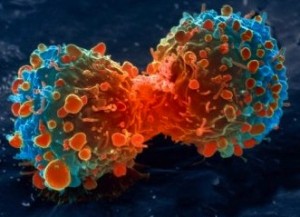 There are other factors that are needed to bring these organelles into the daughter cell through actin cables. These factors are part of the overall process, but also connected in the membrane of each organelle. One factor (Bud6) in fact determines the ability of proteins to diffuse through the membrane. It is also part of the protein that determines whether abnormal protein clumps are kept in the mother cell or transported to the daughter cell.
There are other factors that are needed to bring these organelles into the daughter cell through actin cables. These factors are part of the overall process, but also connected in the membrane of each organelle. One factor (Bud6) in fact determines the ability of proteins to diffuse through the membrane. It is also part of the protein that determines whether abnormal protein clumps are kept in the mother cell or transported to the daughter cell.
The complex signaling between each organelle and the overall cell is just now being discovered, but these signals are necessary for the transfer during reproduction.
Signals Causing Decline
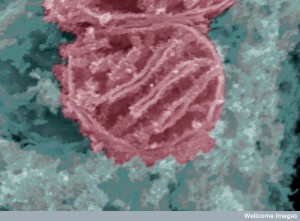 Mechanisms above described how signaling between organelles can accommodate problems in one organelle, but helping elsewhere. This can go the other way, where one organelle’s problems causes a downhill spiral. The studies have been in yeast, where one cell produces 30 daughter cells and then kills itself.
Mechanisms above described how signaling between organelles can accommodate problems in one organelle, but helping elsewhere. This can go the other way, where one organelle’s problems causes a downhill spiral. The studies have been in yeast, where one cell produces 30 daughter cells and then kills itself.
Older mothers are gradually altered with less new features available, even by 100 times. These aging changes are connected to problems in mitochondria such as an abnormal electrical potential at the membrane. The abnormal mitochondria are able to alter genes in the nucleus through signaling pathways. One involves iron-sulfur clusters (ISCs) that are essential for protein functions that are involved in maintaining genetic processes such as multiple kinds of DNA repair. These complex repair processes for alterations in DNA letters and breaks are described in a previous post.
Abnormal mitochondria are transferred in greater number with older mothers. Aged mothers have much less charge in their mitochondria membranes. This affects the acid in the vacuole as well, which is vital for its function. Now, it appears that the change in the less acid (increased pH) in the vacuole can cause the change in the mitochondria membrane. The low acid alters its ability to store amino acids and this somehow affects the mitochondria.
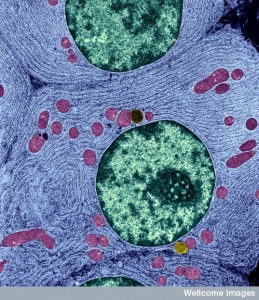 Mitochondria in older mother cells also have alterations in the protein processing in general. Decreased acid in vacuoles reduces proteins in mitochondrial membranes in a unique way, involving sorting, fusion, and autophagy. It doesn’t kill the mitochondria but reverses a particular protein pathway that is normally helpful in stress. The pathway collapses and these proteins appear as clumps in cytoplasm.
Mitochondria in older mother cells also have alterations in the protein processing in general. Decreased acid in vacuoles reduces proteins in mitochondrial membranes in a unique way, involving sorting, fusion, and autophagy. It doesn’t kill the mitochondria but reverses a particular protein pathway that is normally helpful in stress. The pathway collapses and these proteins appear as clumps in cytoplasm.
The increase of pH in the vacuole occurs with competition between vacuole and plasma membrane for protons. This occurs via the normal proton pump at the cell membrane that maintains the cell electrical gradient. This proton pump uses much of the cells ATP energy. This helps transport molecules into the cell and then out in vesicles. This pump makes the vacuole acid. They are both connected to the function of one factor (Pma1) and they compete for protons.
These show interconnections. First reduced acidity in vacuole, and then ten divisions later mitochondrial trouble with proteins. These defects are not transferred to daughter for another ten divisions. This is an example of a negative communication in a spiral of aging.
Conversations Among Organelles
 While signaling is being observed among all cells in nature, it is more difficult to observe conversations among the very tiny organelles inside of cells inside of the body. While organelle communication is in some ways similar to microbe communities, it is much harder to study because it is occurring inside of cells.
While signaling is being observed among all cells in nature, it is more difficult to observe conversations among the very tiny organelles inside of cells inside of the body. While organelle communication is in some ways similar to microbe communities, it is much harder to study because it is occurring inside of cells.
Recent research is now finding particular signals related to many functions. One of the major examples in recent studies involves the ways that proteins are produced, regulated, maintained, and recycled. The quality control programs exist for each organelle and interact. They also exist for the cell as a whole, where organelles can adapt to deal with malfunction of one of the organelles to save the cell. Several examples are given in this post and more are being discovered.
 The pathway for vacuolar protein sorting or VPS goes in the other direction to the vacuole for recycling and can use endocytosis processes.
The pathway for vacuolar protein sorting or VPS goes in the other direction to the vacuole for recycling and can use endocytosis processes.